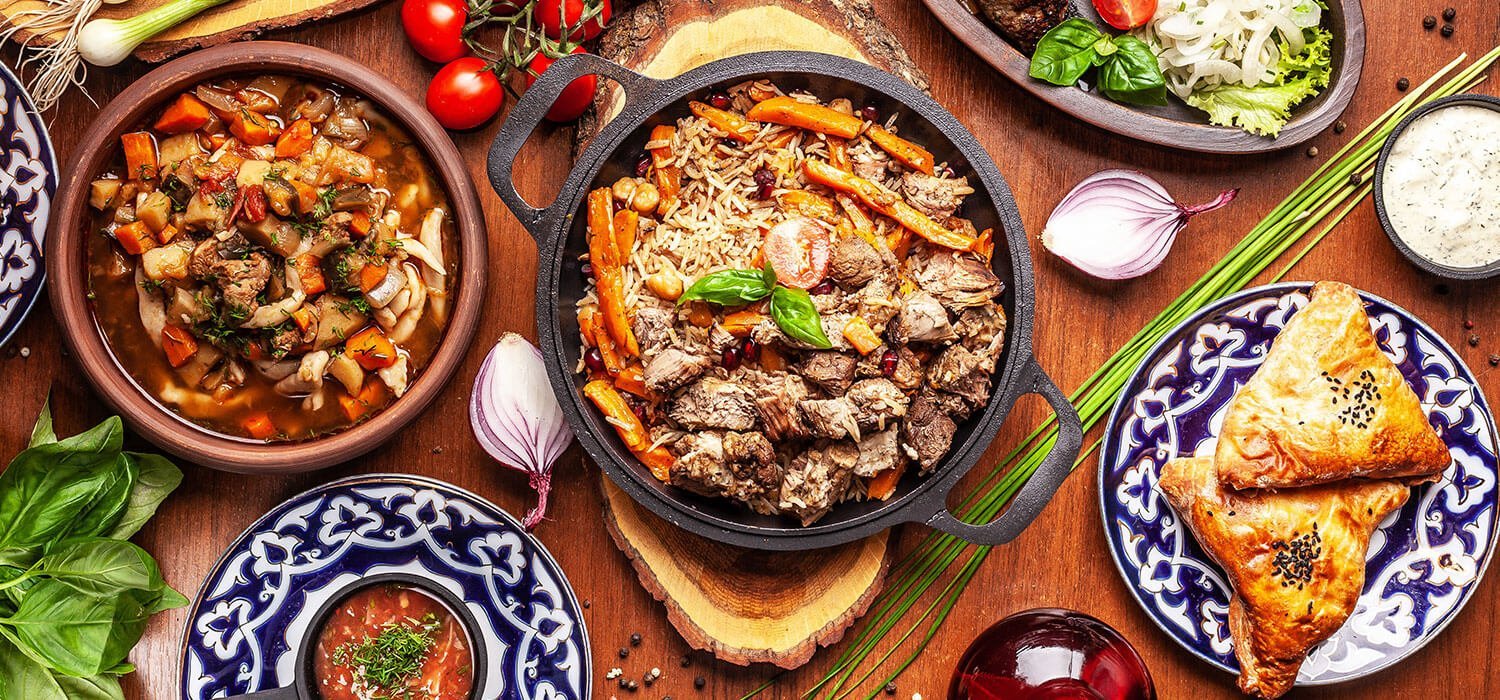Take Me to the Bulgarian Recipes
Bulgaria, a picturesque country located in the southeastern part of Europe, is blessed with a diverse terrain encompassing Black Sea coastline, rivers, mountains, and rich valleys. The climate predominantly ranges from continental to Mediterranean, offering a varied bounty of produce. Central to its rich cultural tapestry is the delectable Bulgarian cuisine.
Bulgarian cuisine is a tantalizing melange of flavors, steeped in history and influenced by various cultures. This Balkan nation’s culinary palette draws heavily from its Slavic roots, intermingled with traces from Greek, Turkish, and even Middle Eastern cuisines. While each dish has its own tale to tell, let’s embark on a delectable journey through some of Bulgaria’s most cherished meals.
With scenic landscapes of the Balkan mountains, dense forests, and serene beaches, Bulgaria is a hidden gem for nature lovers.
The country thrives on agriculture, tourism, and the IT sector and boasts a population of around 7 million proud Bulgarians.
Take Me to the Bulgarian Recipes
Key Takeaways
- Bulgarian cuisine is heavily influenced by its continental to Mediterranean climate.
- It’s known for its rich flavors, hearty dishes, and generous use of fresh produce.
- Yogurt and cheese are staple ingredients in many Bulgarian dishes.
- Seasonal fruits and vegetables play a pivotal role in traditional recipes.
- Most dishes are cooked slowly, ensuring rich flavors and tenderness.
- Festive meals often include a variety of starters, mains, and desserts, showcasing the country’s culinary diversity.
Take Me to the Bulgarian Recipes
Where is Bulgaria?


Index to the Contents
- Take Me to the Bulgarian Recipes
- More Articles
- Interesting Facts about Bulgaria
- The History of Bulgaria and the Impact it has had on the Food
- How Bulgaria’s Climate and Geography has Influenced Bulgarian Cuisine
- Understanding the Essence of Bulgarian Cuisine
- Bulgarian National Food
- Bulgarian Culinary Traditions
- How Healthy is Bulgarian Food?
- Bulgarian Culture Food
- The Most Popular Bulgarian Food
- Great Bulgarian Recipes to Try at Home
- Conclusion
- FAQ’s
You may also be interested in the following articles
- North and South American Cuisine – A Culinary Expedition
- European Cuisine: Savor the Continent’s Best Culinary Secrets!
- African Cuisine: Discover the Bold Flavors & Global Charm!
- Asian Cuisine Unlock its Secrets – Taste, Health & Global Influence!
- Oceania Cooking: A Culinary Journey Through the Pacific
Savor iconic Bulgarian Food Recipes – Click on each tantalizing picture to open up the Recipe
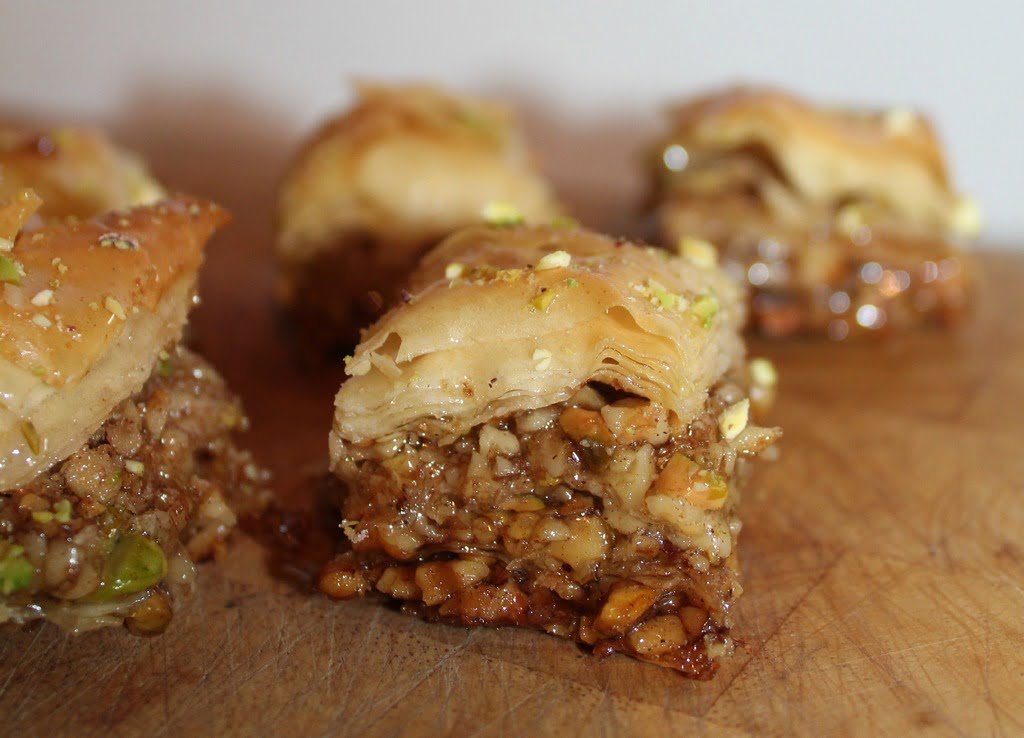
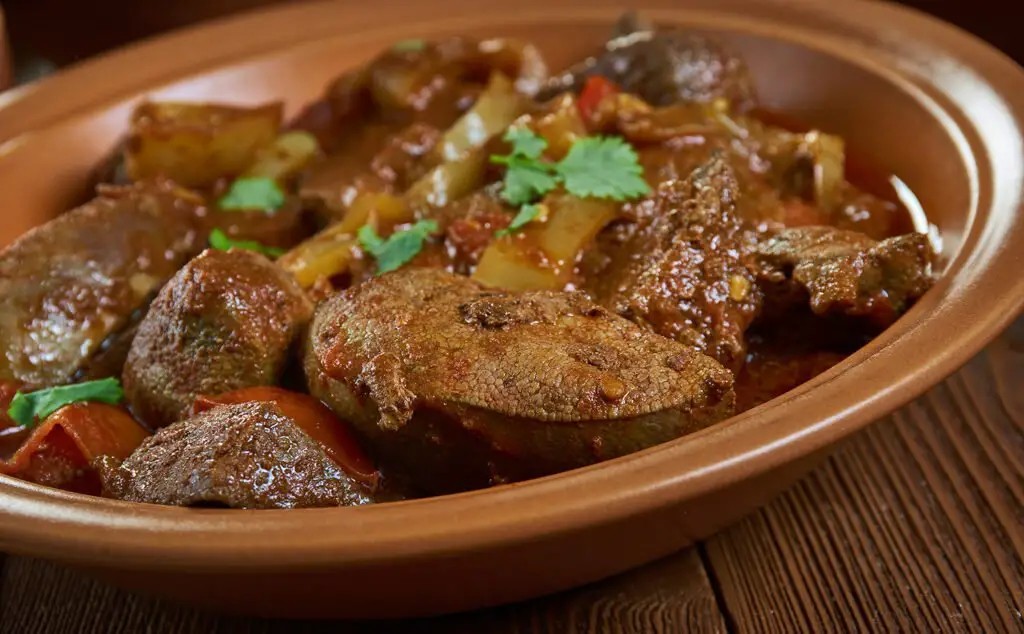
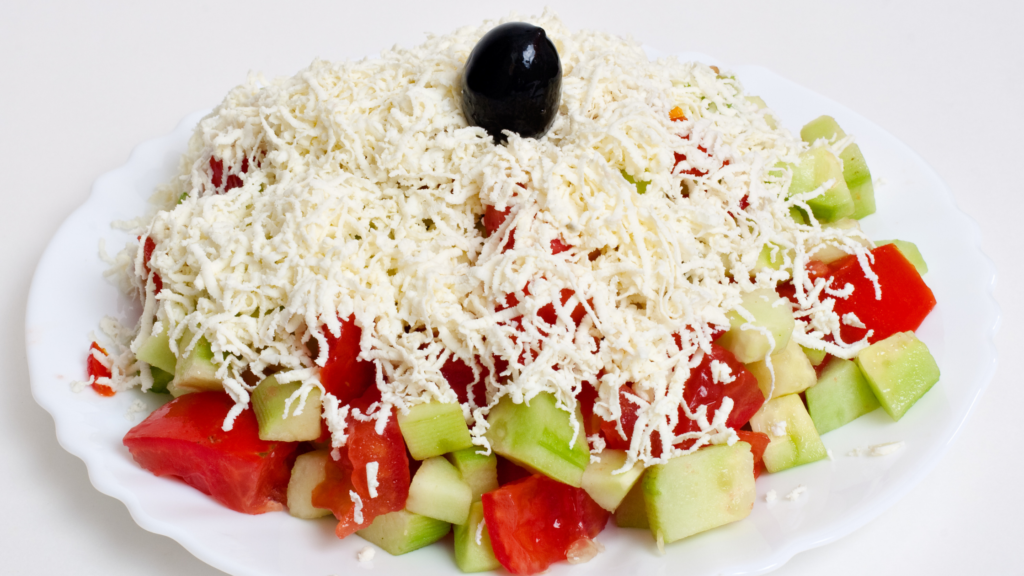


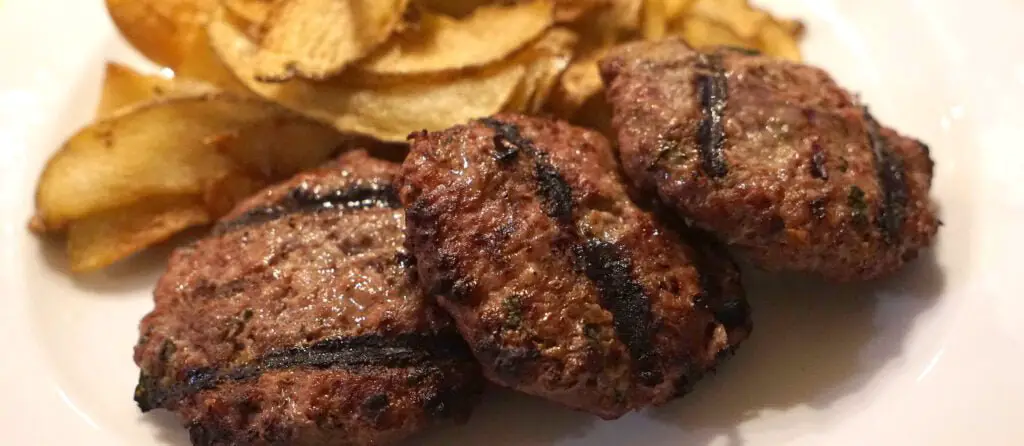
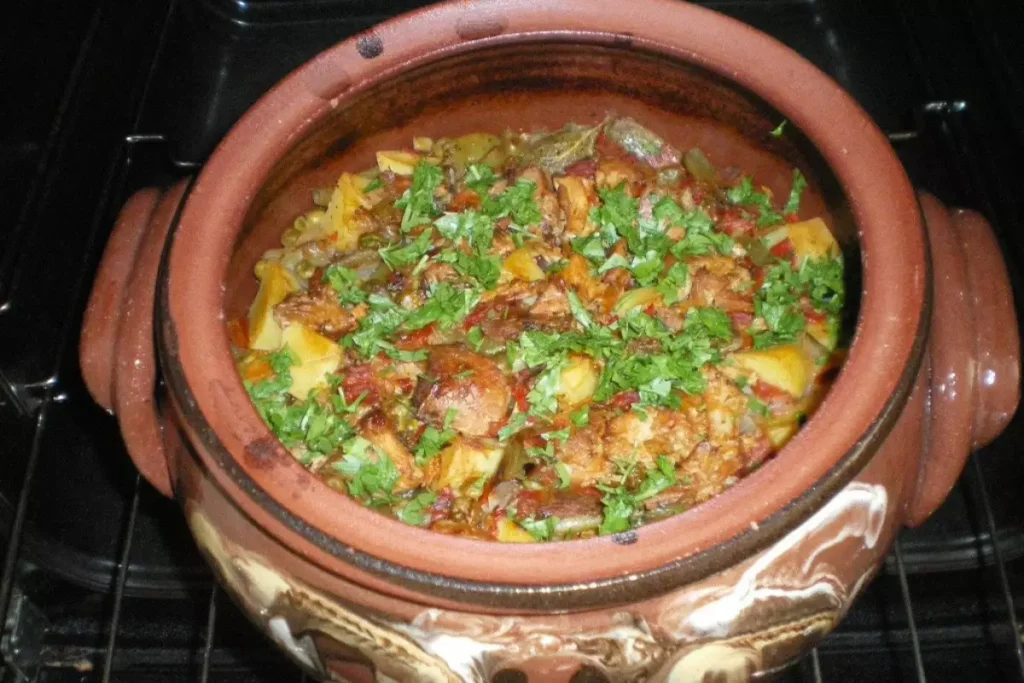
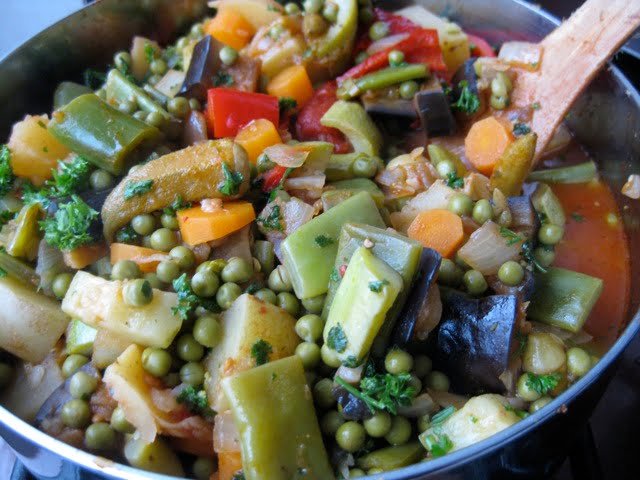
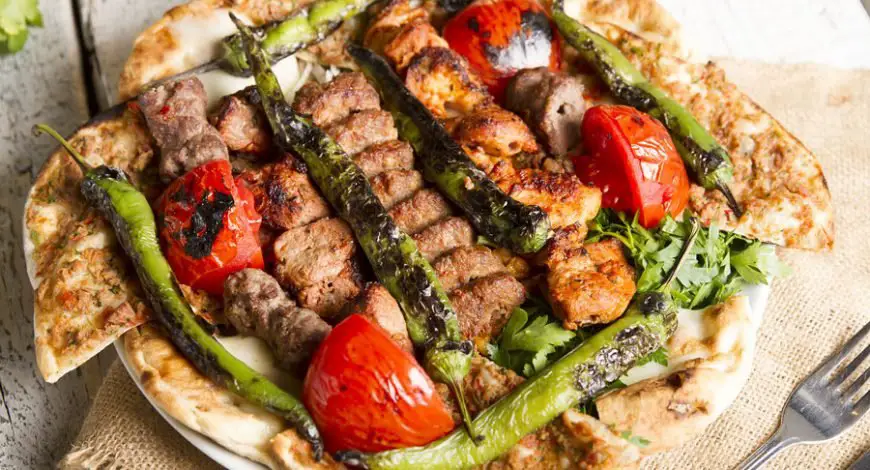


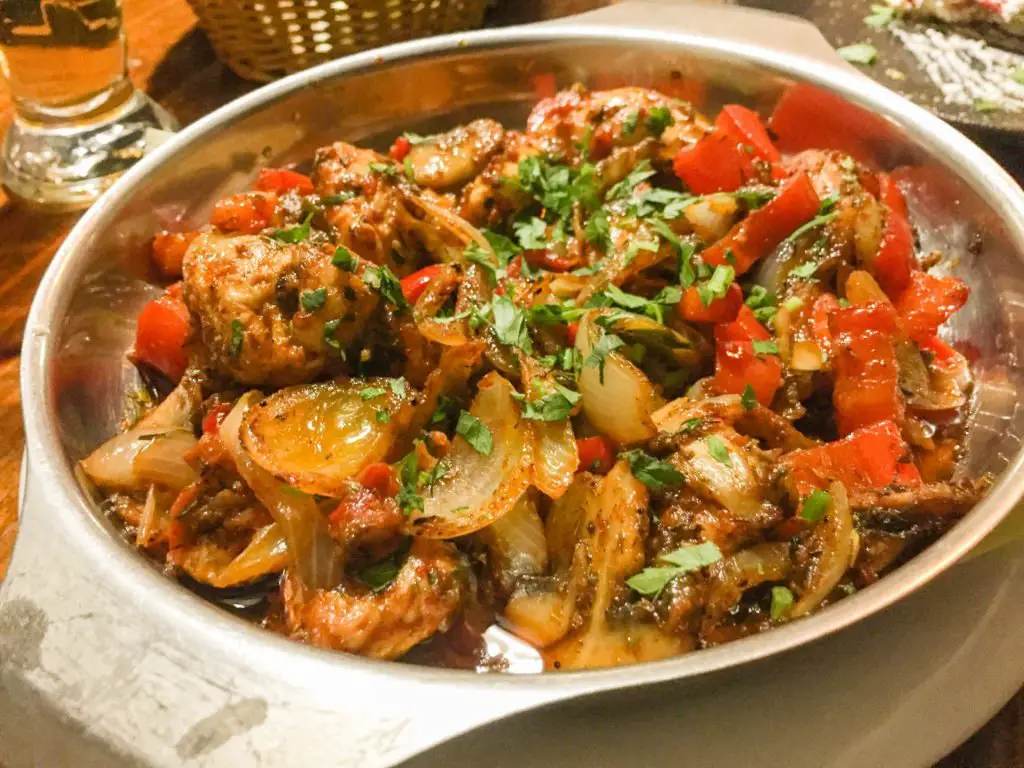
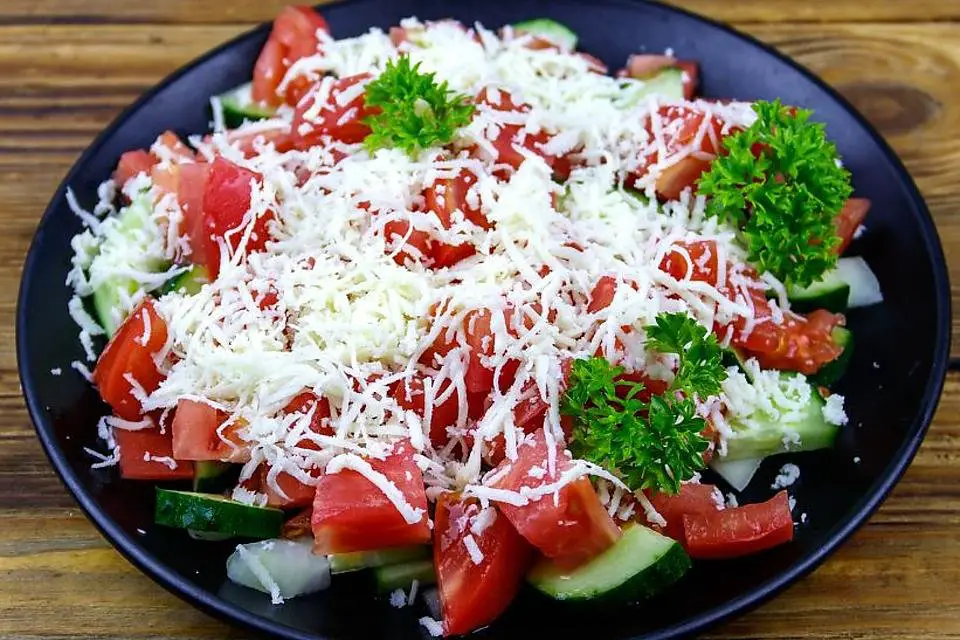
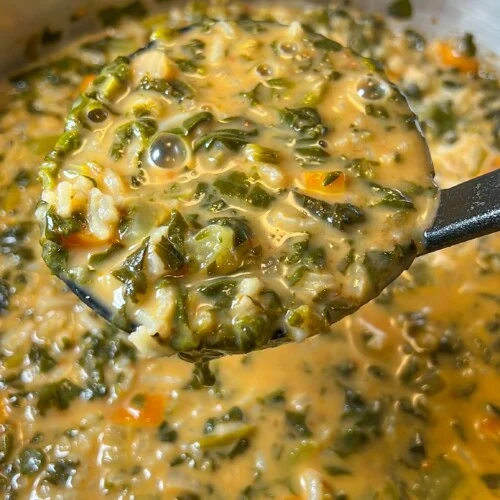
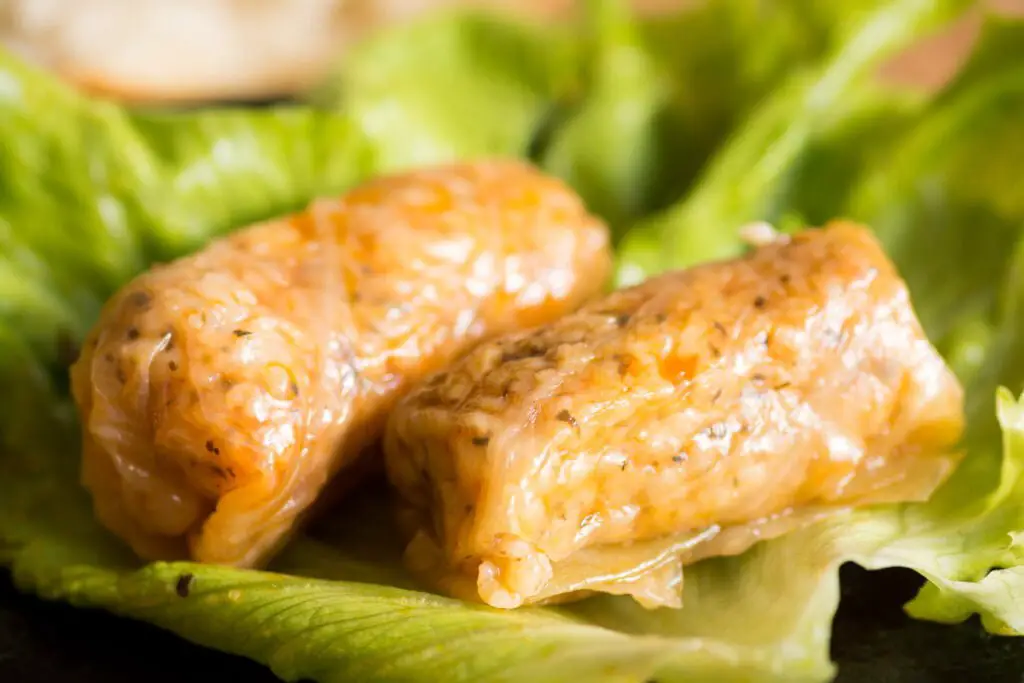
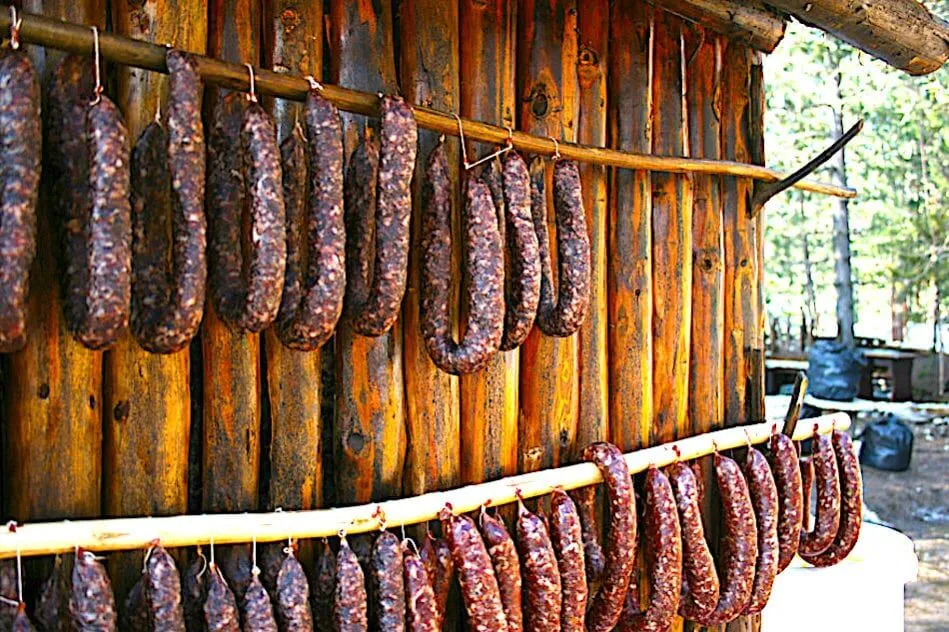





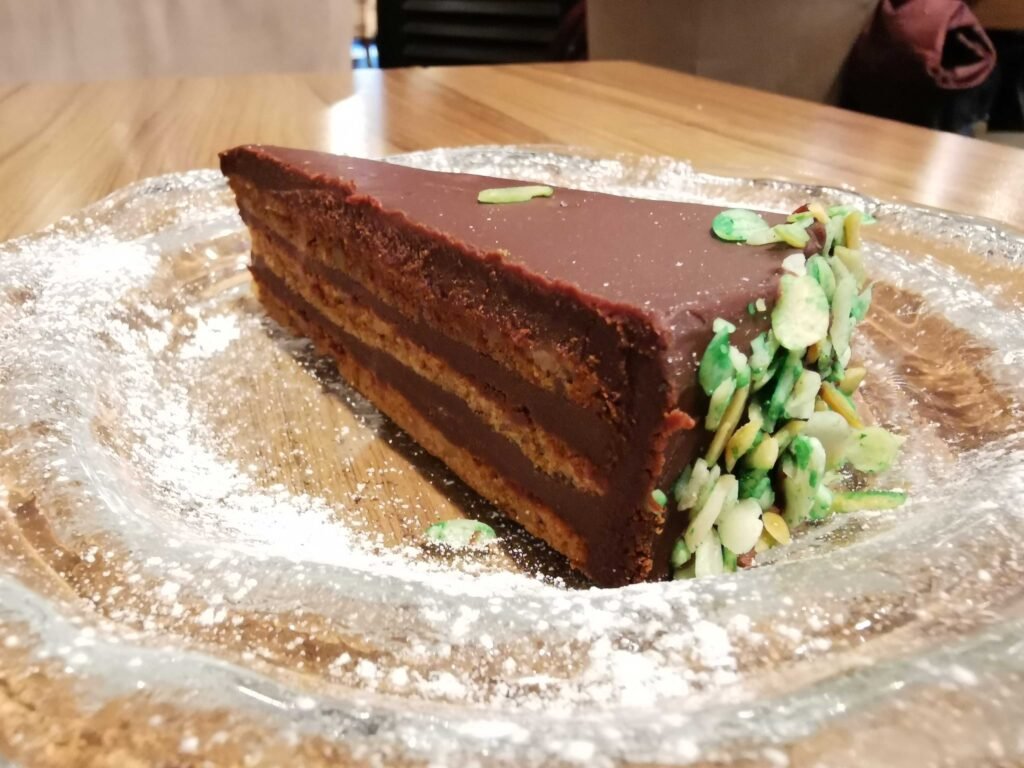
Interesting Facts about Bulgaria
Here are some interesting and fun facts about Bulgaria that you might not know:
Bulgaria is the oldest country with an Unchanged Name
Bulgaria is the oldest country in Europe that has never changed its name since it was founded in 681 AD.
The Cyrillic Alphabet was developed in Bulgaria

Bulgaria is the birthplace of the Cyrillic alphabet, which was created by two brothers, Saints Cyril and Methodius, in the 9th century.
Bulgaria and Yogurt go Together
The country is famous for its yogurt, which is made with a unique bacteria called Lactobacillus bulgaricus. Bulgarians believe that yogurt is the secret to their longevity and health.
Bulgarian Bagpipes

You might think that only Scotland has bagpipes, but you are wrong! Bulgaria and some other countries in Eastern Europe also play bagpipes. They call their bagpipes gaida.
They make them from goat skin, and they are not as hard to play as the Scottish ones.
It is the 2nd largest Producer of Rose Oil
Bulgaria is the world’s second-largest producer and exporter of rose oil, which is used in perfumes and cosmetics. The Rose Valley in central Bulgaria produces about 70% of the world’s rose oil.
Bulgarians shake their heads to say “YES” and Visa Versa!

Bulgaria has a tradition of shaking their head to mean “yes” and nodding to mean “no”. This can be very confusing for foreigners, so be careful when communicating with Bulgarians.
It is Home to 9 UNESCO World Heritage Sites
Bulgaria has nine UNESCO World Heritage Sites, including the Rila Monastery, the Thracian Tomb of Kazanlak, and the ancient city of Nessebar.
Bulgaria has lots of Natural Mineral Springs
The country has the highest number of natural mineral springs in continental Europe, with over 600. Many Bulgarians visit spa resorts and thermal baths to enjoy the healing properties of the water.
It is a great place to watch IMAX 3D movies!

Bulgaria has the world’s largest IMAX 3D cinema screen, which is located in the Arena Mladost cinema in Sofia. The screen measures 32 meters by 18 meters and can seat 530 people.
The oldest Gold Treasure is in Bulgaria

Bulgaria is home to the world’s oldest gold treasure, which dates back to 4600 BC. The treasure consists of over 3,000 gold objects and was discovered in a necropolis near Varna.
Bulgarians Celebrate Baba Marta
Bulgaria has a unique holiday called Baba Marta, which is celebrated on March 1st. On this day, people exchange red and white bracelets or dolls called martenitsas, which symbolize health and happiness.
The martenitsas are worn until the first signs of spring, such as the blooming of a tree or the sighting of a stork.
The History of Bulgaria and the Impact it has had on the Food
Bulgaria has a fascinating history ranging from being a powerful empire through to being conquered state. Today it is a national entity why is an integral part of Eastern Europe.
Bulgarian history and food are closely intertwined, as the cuisine reflects the influences of different cultures and periods that shaped the country. Here are some of the main historical stages and their impact on Bulgarian food:
Bulgaria’s Prehistory and Antiquity
The ancient Thracians, who inhabited the lands of modern Bulgaria, were known for their cultivation of grapes and production of wine. They also consumed dairy products, honey, meat, and bread.
The Thracian dishes influenced the later Bulgarian cuisine, such as the cheese pie banitsa and the yogurt-based soup tarator.
Bulgaria in the Middle Ages
The First and Second Bulgarian Empires were powerful states that dominated the Balkans and interacted with the Byzantine, Roman, and Ottoman empires. The medieval Bulgarian cuisine was influenced by the Slavic, Greek, and Armenian cultures, and introduced new ingredients such as garlic, onion, cabbage, beans, and walnuts.
The Bulgarians also developed their own cheese-making traditions, using sheep and goat milk to produce the white brine cheese sirene
Bulgaria under Ottoman rule

The Ottoman Turks conquered Bulgaria in the 14th century and ruled it for nearly five centuries. The Ottoman cuisine had a profound impact on the Bulgarian food, introducing new spices, dishes, and cooking methods.
Some of the most popular Ottoman dishes that became part of the Bulgarian cuisine are the stuffed vegetables sarmi, the meat and vegetable stew gyuvetch, the grilled meatballs kyufte, and the pastry baklava.
The Ottoman rule also increased the consumption of coffee and tea in Bulgaria.
Bulgaria in the Modern Era

The 19th and 20th centuries saw the emergence of the Bulgarian national revival, the liberation from the Ottoman rule, the formation of the modern Bulgarian state, and the integration into the European Union.
The modern Bulgarian cuisine reflects the diversity and dynamism of the country, incorporating elements from the Western, Eastern, and Mediterranean cuisines.
Some of the modern dishes that are popular in Bulgaria are the shopska salad, the moussaka, the banitsa with spinach, and the pizza. The modern Bulgarian cuisine also preserves the traditional dishes and products, such as the yogurt, the rakia, the kavarma, and the lyutenitsa.
References
- Bulgarian cuisine – Wikipedia,
- Bulgarian cuisine – Bulgarian Inventors and Discoveries – Bulgaropedia,
How Bulgaria’s Climate and Geography has Influenced Bulgarian Cuisine
Bulgaria’s climate and geography have influenced its cuisine in various ways, such as:
Bulgaria’s Climate

The continental climate, with cold winters and hot summers, has led to the consumption of hearty dishes, such as soups, stews, casseroles, and pies, as well as preserved foods, such as pickles, jams, and dried fruits
The humid subtropical climate along the Black Sea coast, with mild winters and long summers, has favored the cultivation of fruits, vegetables, herbs, and spices, as well as the fishing industry. The coastal cuisine is rich in salads, seafood, grilled meats, and desserts.
The Mountainous Terrain

The mountainous terrain, with high altitudes and diverse flora and fauna, has influenced the production of dairy products, such as cheese and yogurt, as well as the breeding of sheep and goats.
The mountain cuisine is based on dairy products, meat, bread, and wild herbs.
Bulgaria’s Geographical Location
The geographical location, at the crossroads of Europe and Asia, has exposed the country to various cultural influences, such as Slavic, Greek, Turkish, Persian, and Mediterranean.
The Bulgarian cuisine has incorporated elements from these cuisines, such as stuffed vegetables, moussaka, kebabs, baklava, and coffee.
References
- Bulgarian cuisine – Wikipedia
- Bulgarian cuisine – Bulgarian Inventors and Discoveries – Bulgaropedia
Understanding the Essence of Bulgarian Cuisine

Bulgarian cuisine, deeply rooted in a rich history and influenced by neighboring cultures, paints a vivid picture of the nation’s past and its values. At its heart, it is simple, yet flavorful, emphasizing fresh ingredients and traditional cooking techniques.
Most meals revolve around locally sourced produce. Vegetables like peppers, tomatoes, and cucumbers are staples, often finding their way into refreshing salads like the popular “Shopska”. Dairy, especially yogurt and white cheese (sirene), is predominant. The famed Bulgarian yogurt, with its unique bacteria strain, is a beverage or dessert and contributes as an ingredient in a variety of dishes.
Chefs season meat, primarily pork, lamb, and chicken, with a blend of herbs and spices and then grilled or slow cooked to perfection. They slow cook the meat dish called Kavarma, and kebapche, spiced meat sausages and the result is one of the most popular dishes nationwide.
Bulgarian Cuisine involves a huge range of Tasty Treats
Complementing these main dishes are a myriad of rich pastries, both savory and sweet. Banitsa, a flaky pastry filled with cheese or other fillings, stands out as a breakfast favorite.
However, more than just the food, Bulgarian cuisine emphasizes communal eating. Meals are a time for families to gather, share stories, and enjoy each other’s company. The Bulgarian table is not just a place for nourishment but a setting for connection and tradition.
In essence, Bulgarian cuisine is a delightful mix of flavors, textures, and traditions. A true culinary journey that offers a glimpse into the soul of the nation.
Bulgarian National Food
The Bulgarian national food is banitsa, a traditional pastry made with layers of filo dough and usually filled with cheese. It is often enjoyed for breakfast or as a snack and is a popular dish during holidays and celebrations in Bulgaria.
Bulgarian Culinary Traditions
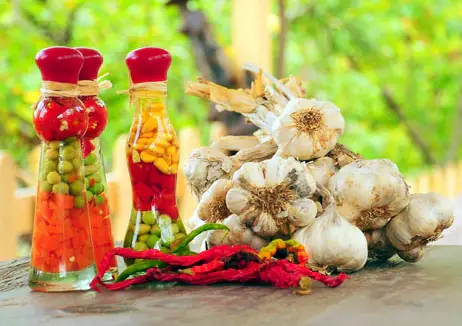
Delving into Bulgarian culinary traditions is akin to embarking on a journey through time and geography. Each dish, technique, and ingredient tells a story of the land, its history, and its people.
A quintessential Bulgarian tradition is the preparation of homemade preserves. As seasons change and bounties arrive, households transform fruits and vegetables into lutenitsa, jams, and pickled delights. These jars capture the essence of summer and sustain families through the cold months.
Christmas Eve in Bulgaria

Festivals and celebrations further illuminate the depth of these traditions. Christmas Eve in Bulgaria, or “Badni Vecher,” showcases a table laden with an odd number of vegetarian dishes, symbolizing hope and gratitude.
Among these, the “kutia,” a wheat berry and walnut mixture, stands as a symbol of prosperity and good health.
Easter in Bulgaria

Easter, another major celebration, has its unique culinary flair with the painting of eggs in vibrant colors and the preparation of kozunak, a sweet bread, marking the end of Lent.
Martenitsa in Bulgaria
Martenitsa, a springtime celebration, doesn’t revolve around food but plays a vital role in Bulgarian culture. On the first of March, people exchange red and white yarn adornments, wishing each other health and happiness. This age-old tradition has transcended generations, binding the nation in a shared moment of joy and hope.
Bulgarian Yoghurt
Perhaps one of the most distinctive traditions is the making of yogurt using a specific bacterium, Lactobacillus bulgaricus. This yogurt has transcended the Bulgarian borders and is lauded for its taste and health benefits globally.
Ultimately, Bulgarian culinary traditions are not just about the food but about the rituals, beliefs, and stories interwoven into the fabric of daily life. Each bite, sip, and shared meal is a testament to the nation’s rich heritage and unwavering spirit.
How Healthy is Bulgarian Food?
Bulgarian food is generally considered healthy, as it is based on fresh and natural ingredients, such as fruits, vegetables, dairy products, meat, and herbs. Bulgarian food also incorporates various fermented foods, such as yogurt, cheese, and pickles, which have probiotic benefits for the gut health and immune system.
However, like any cuisine, Bulgarian food can also have some drawbacks, such as high salt, fat, and sugar content in some dishes, such as cured meats, pastries, and desserts. Some traditional dishes may also be high in calories and carbohydrates, such as moussaka, banitsa, and bread.
Therefore, moderation and balance are important for enjoying Bulgarian food in a healthy way
References
- Traditional Bulgarian Dairy Products to Functional Foods
- Traditional Bulgarian Dairy Products: Ethnic Foods with Health Benefits
- Bulgur Wheat: Nutrition, Benefits, and How to Cook It.
Bulgarian Culture Food
Bulgarian culture food is rich in flavors, influenced by Eastern European and Mediterranean cuisines.
Traditional dishes like banitsa, a savory pastry, and Shopska salad, made with tomatoes, cucumbers, and feta cheese, represent the essence of Bulgarian cuisine.
Popular Bulgarian dishes also include kebapche and kavarma, showcasing the country’s love for meat and robust flavors.
The Most Popular Bulgarian Food
The most popular Bulgarian food includes:
- Shopska salata: A cold salad made with chopped tomatoes, cucumbers, onions, peppers, and grated sirene cheese. It is often considered the national dish of Bulgaria and has the same colors as the flag
- Meshana skara: A mixed grill of various meats, such as pork, chicken, beef, and lamb, seasoned with salt, pepper, and paprika. It is usually served with fries, bread, and salad
- Gyuvech: A slow-cooked stew of meat, vegetables, and spices in a clay pot. It can also include rice, eggs, cheese, or pasta. It is named after the pot it is cooked in and has many regional variations
- Moussaka: A baked dish of minced meat, potatoes, and eggs, topped with yogurt or béchamel sauce. It is influenced by the Greek version, but has a distinct Bulgarian flavor
- Banitsa: A pastry made with layers of filo dough, butter, and cheese, baked until golden and crispy. It can also have other fillings, such as spinach, pumpkin, or meat. It is a popular snack or breakfast item, often eaten with yogurt.
Bulgarian Cuisine – Great Recipes to Try at Home
Bulgarian cuisine is a delightful blend of flavors, textures, and traditions. It mirrors the country’s history, culture, and love for fresh produce. Rich stews, tangy yogurts, savory pastries, and fresh salads dominate the culinary landscape, making Bulgarian food both hearty and wholesome.
Bulgarian Food – Drob po selski

History and Background of Bulgarian Drob po Selski
Drob po Selski, a traditional Bulgarian dish, has deep roots in the country’s rural culinary heritage. The name translates to “village-style liver,” reflecting its humble origins and connection to agrarian life.
Originating from the Balkan region, this dish showcases Bulgaria’s love for organ meats, particularly liver. Drob po Selski is a flavorful and hearty dish that embodies the resourcefulness of Bulgarian cooks, utilizing locally sourced ingredients to create a delicious and satisfying meal.
Bulgarian Food – Drob po selski Ingredients
- 500g chicken or pork liver, sliced
- 1 onion, finely chopped
- 2 cloves garlic, minced
- 2 tablespoons vegetable oil
- 2 tablespoons butter
- 1 cup mushrooms, sliced
- 1/2 cup red wine
- 1 teaspoon paprika
- Salt and pepper to taste
- Fresh parsley for garnish
Bulgarian Food – Drob po selski Recipe
1. Prepare the Liver
- Slice the chicken or pork liver into thin strips.
2. Sauté the Aromatics
- In a large skillet, heat vegetable oil over medium heat.
- Add finely chopped onion and minced garlic, sautéing until softened.
3. Cook the Liver
- Add liver slices to the skillet, cooking until browned on all sides.
4. Add Mushrooms
- Incorporate sliced mushrooms into the skillet, allowing them to cook until softened.
5. Deglaze with Wine
- Pour red wine into the skillet, deglazing the pan and enhancing the flavors.
6. Season
- Sprinkle paprika over the mixture.
- Season with salt and pepper to taste.
7. Finish with Butter
- Add butter to the skillet, allowing it to melt and coat the liver and mushrooms.
8. Garnish and Serve
- Garnish with fresh parsley for added flavor and presentation.
- Serve hot, either on its own or accompanied by crusty bread or potatoes.
Serving: This recipe serves 3-4 people.
Cooking Time: Approximately 20 minutes.
Calories: The total calorie count for this recipe is approximately 300 calories per serving. (Calories may vary based on specific ingredient brands and quantities used.)
Bulgarian Food – Sudzhuk (Sausage)

History and Background of Sudzhuk (Sausage)
Sudzhuk, a traditional Bulgarian sausage, has deep roots in the country’s culinary heritage. Dating back centuries, this flavorful sausage reflects the rich history and diverse influences in Bulgarian cuisine.
Originating from the Balkan region, Sudzhuk has evolved over time, becoming a beloved delicacy enjoyed by many.
Region of Origin
Bulgaria, located in Southeastern Europe on the Balkan Peninsula, is where Sudzhuk has its origins. The country’s culinary traditions, shaped by a blend of Mediterranean, Ottoman, and Slavic influences, contribute to the unique and delicious taste of this sausage.
Ingredients
- 1 kg ground beef
- 300 g pork fat, finely chopped
- 100 g breadcrumbs
- 2 cloves garlic, minced
- 2 tsp salt
- 1 tsp black pepper, ground
- 1 tsp cumin, ground
- 1 tsp paprika
- 1 tsp coriander, ground
- 1/2 tsp red pepper flakes (optional)
- 100 ml red wine
- Natural sausage casings
Recipe for Sudzhuk (Sausage)
Prepare the Ingredients
- Measure and gather all the ingredients.
- Soak the natural sausage casings in warm water for about 30 minutes.
Mix the Ingredients
- In a large mixing bowl, combine the ground beef, chopped pork fat, breadcrumbs, minced garlic, salt, black pepper, cumin, paprika, coriander, and red pepper flakes if using.
- Pour the red wine into the mixture and mix thoroughly until all ingredients are well combined.
Stuff the Sausages
- Rinse the soaked sausage casings under cold water.
- Using a sausage stuffer, fill the casings with the prepared meat mixture, ensuring it is evenly distributed.
Shape and Dry
- Twist the filled casings into sausages, tying knots at the ends.
- Hang the sausages in a cool, dry place for air-drying. Allow them to dry for at least 24 hours.
Cooking
- Once dried, Sudzhuk can be grilled, smoked, or pan-fried until fully cooked.
- Serve hot and enjoy the flavorful Bulgarian Sudzhuk!
Serving Size
This recipe serves approximately 6 people.
Estimated Cooking Time
- Preparation: 30 minutes
- Drying: 24 hours
- Cooking: 15 minutes
Nutritional Information
Note: Caloric values are approximate and may vary based on specific ingredient brands and preparation methods.
- Total Calories: [Provide an estimate based on the ingredients used]
Bulgarian Food – Torta Garash

History and Background of Torta Garash
Torta Garash is a delightful Bulgarian dessert with a rich history that traces back to the early 20th century. Named after the Garash neighborhood in Sofia, the capital of Bulgaria, this cake holds cultural significance and is cherished for its unique flavor and texture.
Combining traditional Bulgarian ingredients with a touch of creativity, Torta Garash has become a beloved treat in the region.
Origin and Region
Bulgarian cuisine is a fusion of flavors influenced by Mediterranean, Ottoman, and Slavic traditions. Torta Garash, with its roots in Bulgaria, reflects the diverse culinary heritage of the country.
The cake is often enjoyed during celebrations and family gatherings, making it a symbol of joy and togetherness.
Ingredients for Torta Garash
Dry Ingredients:
- 2 cups all-purpose flour
- 1 cup cocoa powder
- 2 cups granulated sugar
- 1 teaspoon baking soda
- 1 teaspoon baking powder
- A pinch of salt
Wet Ingredients:
- 4 large eggs
- 1 cup whole milk
- 1 cup sunflower oil
- 1 teaspoon vanilla extract
For the Chocolate Ganache:
- 1 cup heavy cream
- 1 ½ cups dark chocolate chips
For Garnish (Optional):
- Chopped nuts or shredded coconut
Recipe for Torta Garash
Preparing the Cake Batter
- Preheat the oven to 350°F (180°C) and grease two 9-inch round cake pans.
- In a large bowl, sift together the flour, cocoa powder, sugar, baking soda, baking powder, and salt.
- In a separate bowl, whisk together the eggs, milk, sunflower oil, and vanilla extract.
- Gradually add the wet ingredients to the dry ingredients, mixing until smooth and well combined.
Baking the Cake
- Divide the batter evenly between the prepared cake pans.
- Bake in the preheated oven for 25-30 minutes or until a toothpick inserted into the center comes out clean.
- Allow the cakes to cool completely on a wire rack.
Making the Chocolate Ganache
- In a saucepan, heat the heavy cream until it simmers. Remove from heat.
- Add the dark chocolate chips to the hot cream, and let it sit for a minute.
- Stir the mixture until smooth, creating a velvety chocolate ganache.
Assembling the Cake
- Place one cake layer on a serving plate and spread a layer of chocolate ganache on top.
- Add the second cake layer and cover the entire cake with the remaining chocolate ganache.
- Garnish with chopped nuts or shredded coconut if desired.
Serving
- Allow the cake to set before slicing. Torta Garash is ready to be served!
Serving Information
This recipe serves approximately 12 people.
Estimated Cooking Time
- Preparation: 20 minutes
- Baking: 25-30 minutes
- Assembly: 15 minutes
Nutritional Information (Approximate)
- Calories: 4000 kcal (entire cake)
- Serving Size: 1 slice (1/12th of the cake)
Bulgarian Food – Zelenchukova Supa (Spinach Soup)

History and Background of Bulgarian Spinach Soup
Bulgarian Spinach Soup, known as “Zelenchukova Supa,” holds its roots in the heart of the Balkan region. Originating from Bulgaria’s rich culinary heritage, this soup reflects the country’s commitment to simple yet flavorful dishes.
Spinach, a nutrient-rich leafy green, is widely cultivated in the fertile lands, making it a staple ingredient in Bulgarian cuisine. The soup not only showcases the abundance of fresh, locally sourced vegetables but also exemplifies the health-conscious approach that Bulgarians take towards their meals.
Bulgarian Food – Zelenchukova Supa Ingredients
- 1 bunch fresh spinach, chopped
- 1 large potato, peeled and diced
- 1 onion, finely chopped
- 1 carrot, sliced
- 2 cloves garlic, minced
- 4 cups vegetable or chicken broth
- 2 tablespoons olive oil
- 1 teaspoon paprika
- Salt and pepper to taste
- Lemon wedges for serving
Bulgarian Food – Zelenchukova Supa Recipe
1. Prepare the Vegetables
- Wash and chop the fresh spinach.
- Peel and dice the potato.
- Finely chop the onion, slice the carrot, and mince the garlic.
2. Sauté the Aromatics
- In a large pot, heat olive oil over medium heat.
- Add chopped onion and minced garlic, sautéing until softened.
3. Add Potatoes and Carrots
- Stir in diced potatoes and sliced carrots, cooking for a few minutes until they begin to soften.
4. Incorporate Spinach
- Add chopped spinach to the pot, allowing it to wilt and reduce in volume.
5. Season the Soup
- Sprinkle paprika over the vegetables.
- Season with salt and pepper to taste.
6. Pour in Broth
- Pour vegetable or chicken broth into the pot, ensuring it covers the vegetables.
7. Simmer
- Bring the soup to a boil, then reduce the heat to low and simmer until the potatoes are tender, typically around 15-20 minutes.
8. Serve
- Ladle the Spinach Soup into bowls.
- Serve hot, accompanied by lemon wedges for a hint of freshness.
Serving: This recipe serves 4 people.
Cooking Time: Approximately 30 minutes.
Calories: The total calorie count for this recipe is approximately 150 calories per serving. (Calories may vary based on specific ingredient brands and quantities used.)
Bulgarian Food – White Brine Cheese Sirene

History and Background of Bulgarian White Brine Cheese (Sirene)
Bulgarian White Brine Cheese, known as Sirene, has a rich history rooted in the culinary traditions of Bulgaria. This cheese has been a staple in Bulgarian cuisine for centuries, with its origins dating back to ancient times.
Sirene is an essential part of various traditional dishes, offering a unique taste and texture. The cheese is made from sheep’s, cow’s, or goat’s milk and is often associated with the diverse and flavorful dishes of the Balkan region.
Bulgarian Food – White Brine Cheese Sirene Ingredients
- 500g Bulgarian White Brine Cheese (Sirene)
- 2 large tomatoes, diced
- 1 cucumber, finely chopped
- 1 red onion, thinly sliced
- 1 green bell pepper, diced
- 1/4 cup black olives, pitted and sliced
- 2 tablespoons fresh parsley, chopped
- 3 tablespoons olive oil
- 1 tablespoon red wine vinegar
- Salt and pepper to taste
Bulgarian Food – White Brine Cheese Sirene Recipe
1. Prepare the Ingredients
- Dice the tomatoes.
- Finely chop the cucumber.
- Thinly slice the red onion.
- Dice the green bell pepper.
- Pit and slice the black olives.
- Chop the fresh parsley.
2. Crumble the Sirene Cheese
- Crumble the Bulgarian White Brine Cheese (Sirene) into bite-sized pieces.
3. Assemble the Salad
- In a large bowl, combine the crumbled Sirene cheese, diced tomatoes, chopped cucumber, sliced red onion, diced green bell pepper, sliced black olives, and chopped parsley.
4. Prepare the Dressing
- In a small bowl, whisk together the olive oil and red wine vinegar.
- Season the dressing with salt and pepper to taste.
5. Dress the Salad
- Pour the dressing over the salad ingredients.
- Gently toss the salad until all the ingredients are well-coated with the dressing.
6. Serve and Enjoy
- Allow the salad to marinate for a few minutes before serving.
- Serve the Bulgarian White Brine Cheese (Sirene) salad as a refreshing and flavorful side dish.
Serving: This recipe serves 4 people.
Cooking Time: Approximately 15 minutes.
Calories: The total calorie count for this recipe is approximately 300 calories per serving. (Calories may vary based on specific ingredient brands and quantities used.)
Bulgarian Food – Stuffed Vegetables Sarmi

History and Background of Bulgarian Stuffed Vegetables (Sarmi)
Stuffed Vegetables, locally known as Sarmi, are a cherished part of Bulgarian culinary heritage. This traditional dish reflects the rich history and cultural diversity of Bulgaria.
Sarmi can be traced back to Ottoman influences in the region, and today it remains a symbol of festive occasions and family gatherings. The dish typically consists of vegetables, often grape leaves, stuffed with a flavorful mixture of rice, meat, and aromatic herbs, creating a delightful blend of tastes and textures.
Bulgarian Food – Stuffed Vegetables Sarmi Ingredients
- 12 large grape leaves (fresh or preserved)
- 1 cup rice, uncooked
- 250g ground meat (beef, pork, or a mixture)
- 1 onion, finely chopped
- 2 tomatoes, grated
- 1/4 cup fresh parsley, chopped
- 1/4 cup dill, chopped
- 2 tablespoons olive oil
- 1 teaspoon paprika
- Salt and pepper to taste
- 1 cup vegetable broth
- 1 lemon, sliced (for garnish)
Bulgarian Food – Stuffed Vegetables Sarmi Recipe
1. Prepare the Grape Leaves
- If using preserved grape leaves, rinse them under cold water to remove excess salt.
- If using fresh grape leaves, blanch them in boiling water for 2-3 minutes, then drain and set aside.
2. Prepare the Filling
- In a bowl, combine the uncooked rice, ground meat, chopped onion, grated tomatoes, chopped parsley, chopped dill, olive oil, paprika, salt, and pepper.
3. Stuff the Grape Leaves
- Place a grape leaf flat on a surface, shiny side down.
- Spoon a small amount of the filling onto the center of the leaf.
- Fold the sides of the leaf over the filling and roll it into a compact cylinder.
- Repeat until all grape leaves are stuffed.
4. Arrange in a Pot
- Place the stuffed grape leaves snugly in a large pot, creating layers.
- Pour vegetable broth over the stuffed grape leaves.
5. Cook the Sarmi
- Cover the pot and bring it to a gentle boil over medium heat.
- Reduce the heat to low and let it simmer for 40-45 minutes or until the rice is tender.
6. Serve and Garnish
- Once cooked, transfer the Stuffed Vegetables (Sarmi) to a serving plate.
- Garnish with lemon slices for a burst of freshness.
Serving: This recipe serves 4-6 people.
Cooking Time: Approximately 45 minutes.
Calories: The total calorie count for this recipe is approximately 250 calories per serving. (Calories may vary based on specific ingredient brands and quantities used.)
Bulgarian Food – Meat and Vegetable Stew Gyuvetch

History and Background of Bulgarian Meat and Vegetable Stew (Gyuvetch)
Gyuvetch is a hearty Bulgarian stew with a history deeply rooted in Balkan cuisine. This dish has been a mainstay in Bulgarian households for generations, offering a comforting blend of meats, vegetables, and aromatic spices.
Originating from the rural regions, Gyuvetch reflects the country’s agricultural traditions, combining locally sourced meats and fresh produce. The slow-cooking method enhances the flavors, creating a wholesome and satisfying dish enjoyed during festive occasions and everyday family meals.
Bulgarian Food – Meat and Vegetable Stew Gyuvetch Ingredients
- 500g stewing beef, cubed
- 1 cup pork, diced
- 2 large onions, chopped
- 3 tomatoes, peeled and chopped
- 2 red bell peppers, sliced
- 2 carrots, sliced
- 1 eggplant, diced
- 1 zucchini, diced
- 4 potatoes, peeled and cubed
- 3 cloves garlic, minced
- 1/4 cup vegetable oil
- 1 tablespoon tomato paste
- 1 teaspoon paprika
- 1 teaspoon dried thyme
- Salt and pepper to taste
- 2 cups water or beef broth
Bulgarian Food – Meat and Vegetable Stew Gyuvetch Recipe
1. Prepare the Meat and Vegetables
- Cube the stewing beef and dice the pork.
- Chop the onions, peel and chop the tomatoes, and slice the red bell peppers.
- Slice the carrots, dice the eggplant and zucchini, and peel and cube the potatoes.
- Mince the garlic.
2. Sauté the Meat
- In a large pot, heat vegetable oil over medium heat.
- Add the stewing beef and pork, and brown the meat on all sides.
3. Add Aromatics and Vegetables
- Add chopped onions and minced garlic to the pot.
- Stir in tomato paste, paprika, and dried thyme.
- Add the chopped tomatoes, sliced red bell peppers, sliced carrots, diced eggplant, diced zucchini, and cubed potatoes.
4. Season and Simmer
- Season with salt and pepper to taste.
- Pour water or beef broth into the pot.
- Bring the mixture to a boil, then reduce heat to low, cover, and simmer for 1.5 to 2 hours or until the meats are tender.
5. Serve and Enjoy
- Once cooked, ladle the Meat and Vegetable Stew (Gyuvetch) into bowls.
- Serve hot and savor the rich flavors of this traditional Bulgarian dish.
Serving: This recipe serves 6-8 people.
Cooking Time: Approximately 2 hours.
Calories: The total calorie count for this recipe is approximately 400 calories per serving. (Calories may vary based on specific ingredient brands and quantities used.)
Bulgarian Food – Grilled Meatballs Kyufte

History and Background of Bulgarian Grilled Meatballs (Kyufte)
Grilled Meatballs, known as Kyufte, are a popular dish in Bulgarian cuisine with a history deeply rooted in the country’s culinary traditions. Originating from the Balkan region, Kyufte has been a staple in Bulgarian households for generations.
This dish represents the essence of communal dining and celebration, often enjoyed during festive occasions, family gatherings, and outdoor events. Kyufte showcases the rich flavors of seasoned ground meat, grilled to perfection, making it a beloved dish among locals and visitors alike.
Bulgarian Food – Grilled Meatballs Kyufte Ingredients
- 500g ground beef
- 1 large onion, finely chopped
- 2 cloves garlic, minced
- 1/4 cup fresh parsley, chopped
- 1 teaspoon ground cumin
- 1 teaspoon paprika
- 1 teaspoon salt
- 1/2 teaspoon black pepper
- 1 egg
- 1/4 cup breadcrumbs
- 2 tablespoons vegetable oil (for grilling)
Bulgarian Food – Grilled Meatballs Kyufte Recipe
1. Prepare the Meat Mixture
- In a large mixing bowl, combine ground beef, finely chopped onion, minced garlic, chopped fresh parsley, ground cumin, paprika, salt, and black pepper.
2. Add Binders
- Crack an egg into the mixture to act as a binder.
- Incorporate breadcrumbs to help hold the meatballs together.
3. Mix Thoroughly
- Use your hands to thoroughly mix the ingredients until well combined.
4. Shape into Meatballs
- Take portions of the meat mixture and shape them into round meatballs, ensuring they are evenly sized.
5. Preheat the Grill
- Preheat the grill to medium-high heat.
6. Grill the Kyufte
- Brush the meatballs with vegetable oil to prevent sticking.
- Place the Kyufte on the preheated grill and cook for 4-5 minutes on each side or until they reach the desired level of doneness.
7. Serve and Enjoy
- Once grilled, transfer the Kyufte to a serving platter.
- Serve hot with your favorite side dishes or in a traditional Bulgarian style with flatbread.
Serving: This recipe makes approximately 4 servings.
Cooking Time: Approximately 15-20 minutes.
Calories: The total calorie count for this recipe is approximately 250 calories per serving. (Calories may vary based on specific ingredient brands and quantities used.)
Bulgarian Food – Pastry Baklava

History and Background of Bulgarian Pastry Baklava
Baklava, a delectable sweet pastry, has a rich history in Bulgarian culinary heritage. Originating from the Ottoman Empire, this dessert made its way into Bulgarian cuisine, becoming a beloved treat for special occasions and celebrations. Layers of flaky pastry, walnuts, and sweet syrup create a symphony of flavors and textures, showcasin
g the influence of diverse cultures in the region. Baklava has evolved over centuries, with each bite representing a delightful fusion of tradition and indulgence.
Bulgarian Food – Pastry Baklava Ingredients
- 1 package phyllo dough (thawed, if frozen)
- 1 cup unsalted butter, melted
- 2 cups walnuts, finely chopped
- 1 cup granulated sugar
- 1 teaspoon ground cinnamon
- 1 cup water
- 1 cup granulated sugar
- 1/2 cup honey
- 1 teaspoon lemon juice
Bulgarian Food – Pastry Baklava Recipe
1. Prepare the Nut Filling
- In a bowl, combine finely chopped walnuts, granulated sugar, and ground cinnamon.
2. Layer the Phyllo Dough
- Preheat the oven to 350°F (175°C).
- Brush a baking dish with melted butter.
- Place a sheet of phyllo dough in the dish and brush it with melted butter. Repeat until you have several layers.
3. Add the Nut Mixture
- Sprinkle a generous layer of the nut filling over the buttered phyllo dough.
4. Continue Layering
- Add more layers of phyllo dough, brushing each layer with melted butter.
- Alternate between layers of phyllo dough and the nut mixture until you run out.
5. Cut into Squares
- Using a sharp knife, cut the layered pastry into squares or diamond shapes.
6. Bake
- Bake in the preheated oven for 30-35 minutes or until the Baklava turns golden brown.
7. Make the Syrup
- While the Baklava is baking, prepare the syrup by combining water, granulated sugar, honey, and lemon juice in a saucepan. Simmer for 10 minutes.
8. Pour the Syrup
- Once the Baklava is out of the oven, immediately pour the warm syrup over the hot pastry. Allow it to absorb the syrup and cool.
9. Serve and Enjoy
- Let the Baklava cool completely before serving.
- Serve the delicious Bulgarian Pastry Baklava as a sweet ending to your meal.
Serving: This recipe makes approximately 20 servings.
Cooking Time: Approximately 30-35 minutes.
Calories: The total calorie count for this recipe is approximately 250 calories per serving. (Calories may vary based on specific ingredient brands and quantities used.)
Bulgarian Food – Hopska Salad

History and Background of Bulgarian Hopska Salad
Hopska Salad, a fresh and vibrant dish, has its roots in the culinary traditions of Bulgaria. Originating from the fertile lands of the Balkan region, this salad is named after the Hopsko region. Bulgarian Hopska Salad is a celebration of seasonal produce and simplicity.
It reflects the agrarian history of the area, where locals embraced the bounty of the land, combining tomatoes, cucumbers, peppers, and cheese to create a refreshing salad that captures the essence of Bulgarian hospitality.
Bulgarian Food – Hopska Salad Ingredients
- 4 large tomatoes, diced
- 2 cucumbers, diced
- 1 red onion, finely sliced
- 1 green bell pepper, diced
- 200g feta cheese, crumbled
- 1/4 cup black olives, pitted and sliced
- 3 tablespoons olive oil
- 1 tablespoon red wine vinegar
- Salt and pepper to taste
- 1 teaspoon dried oregano (optional)
Bulgarian Food – Hopska Salad Recipe
1. Prepare the Vegetables
- Dice the tomatoes and cucumbers.
- Finely slice the red onion.
- Dice the green bell pepper.
2. Assemble the Salad
- In a large salad bowl, combine the diced tomatoes, diced cucumbers, sliced red onion, diced green bell pepper, crumbled feta cheese, and sliced black olives.
3. Make the Dressing
- In a small bowl, whisk together olive oil and red wine vinegar.
- Season the dressing with salt and pepper to taste. Add dried oregano for an extra burst of flavor if desired.
4. Dress the Salad
- Pour the dressing over the salad ingredients.
- Gently toss the salad until all the ingredients are well-coated with the dressing.
5. Serve and Enjoy
- Allow the Hopska Salad to chill in the refrigerator for at least 15 minutes before serving.
- Serve as a refreshing side dish, capturing the essence of Bulgarian culinary simplicity.
Serving: This recipe serves 4 people.
Preparation Time: Approximately 15 minutes.
Calories: The total calorie count for this recipe is approximately 200 calories per serving. (Calories may vary based on specific ingredient brands and quantities used.)
Bulgarian Food – Pizza

History and Background of Bulgarian Pizza
Bulgarian pizza, although influenced by Italian cuisine, has developed its unique character, reflecting the local flavors and preferences of the region.
Introduced in Bulgaria during the 20th century, pizza quickly became a popular and versatile dish, adapting to the diverse tastes of Bulgarians. Whether enjoyed in pizzerias or homemade, Bulgarian pizza often features a variety of fresh and local ingredients, showcasing the country’s agricultural abundance.
Today, it stands as a beloved comfort food that brings people together over a shared meal.
Bulgarian Food – Pizza Ingredients
- 1 pre-made pizza dough or pizza crust
- 1/2 cup tomato sauce
- 1 cup shredded mozzarella cheese
- 1/2 cup Bulgarian feta cheese, crumbled
- 1 medium tomato, sliced
- 1/2 red onion, thinly sliced
- 1 bell pepper (any color), sliced
- 10-12 black olives, pitted and sliced
- 1 teaspoon dried oregano
- 1 teaspoon dried basil
- 2 tablespoons olive oil
- Salt and pepper to taste
Bulgarian Food – Pizza Recipe
1. Preheat the Oven
- Preheat your oven according to the instructions on the pizza dough package.
2. Roll Out the Dough
- Roll out the pre-made pizza dough on a floured surface or use a pre-made pizza crust.
3. Prepare the Sauce
- Spread a thin layer of tomato sauce over the rolled-out pizza dough.
4. Add Cheese and Toppings
- Sprinkle shredded mozzarella cheese evenly over the sauce.
- Distribute crumbled Bulgarian feta cheese on top.
- Arrange tomato slices, red onion slices, bell pepper slices, and black olive slices as desired.
5. Season and Drizzle
- Sprinkle dried oregano and dried basil over the toppings.
- Drizzle olive oil over the entire pizza.
- Season with salt and pepper to taste.
6. Bake
- Place the pizza in the preheated oven and bake according to the dough or crust instructions, typically around 12-15 minutes or until the crust is golden and the cheese is melted and bubbly.
7. Serve and Enjoy
- Once baked, remove the Bulgarian pizza from the oven.
- Allow it to cool for a few minutes before slicing.
- Serve and enjoy this delightful fusion of Italian and Bulgarian flavors.
Serving: This recipe serves 3-4 people.
Cooking Time: Approximately 15 minutes.
Calories: The total calorie count for this recipe is approximately 300 calories per serving. (Calories may vary based on specific ingredient brands and quantities used.)
Bulgarian Food – Kavarma

History and Background of Bulgarian Kavarma
Kavarma, a flavorful Bulgarian dish, has deep roots in the country’s culinary history. Originating from rural traditions, Kavarma is a slow-cooked stew that captures the essence of Balkan cuisine.
This dish reflects the resourcefulness of Bulgarian cooks, who utilized locally available ingredients to create a hearty and satisfying meal.
Kavarma’s popularity lies in its rich flavors, combining various meats, vegetables, and spices in a slow-cooking process that enhances the taste and tenderness of the ingredients.
Bulgarian Food – Kavarma Ingredients
- 500g pork shoulder, cubed
- 500g chicken thighs, boneless and skinless, cubed
- 1 large onion, finely chopped
- 2 bell peppers (any color), diced
- 2 tomatoes, peeled and chopped
- 3 cloves garlic, minced
- 1/4 cup vegetable oil
- 1 teaspoon paprika
- 1 teaspoon ground cumin
- 1 teaspoon dried thyme
- Salt and pepper to taste
- Fresh parsley for garnish
Bulgarian Food – Kavarma Recipe
1. Prepare the Meat and Vegetables
- Cube the pork shoulder and chicken thighs into bite-sized pieces.
- Finely chop the onion, dice the bell peppers, peel and chop the tomatoes, and mince the garlic.
2. Sauté the Meat
- In a large, oven-safe pot, heat vegetable oil over medium heat.
- Add the cubed pork and chicken, and brown them on all sides.
3. Add Aromatics and Vegetables
- Add the chopped onion and minced garlic to the pot, sautéing until softened.
- Stir in paprika, ground cumin, and dried thyme.
- Add diced bell peppers and chopped tomatoes, mixing well.
4. Season and Slow Cook
- Season the mixture with salt and pepper to taste.
- Cover the pot and let the Kavarma simmer on low heat for 1.5 to 2 hours, allowing the flavors to meld and the meats to become tender.
5. Garnish and Serve
- Once cooked, garnish with fresh parsley.
- Serve the Kavarma hot, either on its own or over rice or potatoes.
Serving: This recipe serves 4-6 people.
Cooking Time: Approximately 2 hours.
Calories: The total calorie count for this recipe is approximately 300 calories per serving. (Calories may vary based on specific ingredient brands and quantities used.)
Bulgarian Food – Lyutenitsa

History and Background of Bulgarian Lyutenitsa
Lyutenitsa, a staple in Bulgarian cuisine, holds a special place in the hearts of locals. Originating from the Balkan region, this savory spread has been a part of Bulgarian culinary traditions for centuries.
Lyutenitsa is known for its rich, smoky flavor and versatility, often enjoyed as a condiment or spread. Traditionally prepared during the harvest season, it showcases the bounty of ripe tomatoes and peppers.
This flavorful concoction reflects the agricultural heritage of Bulgaria, where families come together to create and savor this beloved dish.
Bulgarian Food – Lyutenitsa Ingredients
- 1 kg red bell peppers, roasted and peeled
- 500g tomatoes, peeled and diced
- 2 large onions, finely chopped
- 4 cloves garlic, minced
- 1/2 cup vegetable oil
- 2 tablespoons tomato paste
- 1 tablespoon sugar
- 1 tablespoon salt
- 1 teaspoon black pepper
- 1 teaspoon paprika
- 1/2 teaspoon chili flakes (optional)
Bulgarian Food – Lyutenitsa Recipe
1. Roast and Peel the Peppers
- Roast red bell peppers until the skin is charred.
- Allow them to cool, then peel off the skin, remove seeds, and chop the flesh.
2. Sauté the Aromatics
- In a large pot, heat vegetable oil over medium heat.
- Add finely chopped onions and minced garlic, sautéing until softened.
3. Add Tomatoes and Peppers
- Stir in diced tomatoes and roasted, chopped red bell peppers.
4. Cook and Thicken
- Mix in tomato paste, sugar, salt, black pepper, paprika, and chili flakes (if using).
- Simmer the mixture over low heat, stirring occasionally, until it thickens to a spreadable consistency.
5. Blend or Mash
- For a smoother texture, use an immersion blender to puree the Lyutenitsa. Alternatively, mash it with a potato masher for a chunkier consistency.
6. Adjust Seasoning
- Taste and adjust the seasoning, adding more salt, sugar, or chili flakes if needed.
7. Jar and Store
- Ladle the Lyutenitsa into sterilized jars.
- Seal the jars while the mixture is still hot to help with preservation.
8. Serve and Enjoy
- Allow the Lyutenitsa to cool before storing in the refrigerator.
- Serve it as a condiment with bread, grilled meats, or as a flavorful addition to various dishes.
Serving: This recipe makes approximately 4 cups of Lyutenitsa.
Cooking Time: Approximately 1 hour.
Calories: The total calorie count for this recipe is approximately 20 calories per tablespoon. (Calories may vary based on specific ingredient brands and quantities used.)
Bulgarian Food – Shopska Salata

History and Background of Bulgarian Shopska Salata
Shopska Salata, a refreshing Bulgarian salad, embodies the vibrant flavors of the region. Originating in the mid-20th century, it was created by Bulgarian chefs to showcase the country’s high-quality produce.
Named after the Shopluk region, this salad has become a symbol of Bulgaria’s agricultural abundance. Characterized by its colorful presentation and simple yet delicious combination of fresh vegetables and feta cheese,
Shopska Salata is a beloved dish that reflects the health-conscious and culinary pride of Bulgarians.
Bulgarian Food – Shopska Salata Ingredients
- 4 large tomatoes, diced
- 1 cucumber, diced
- 1 green bell pepper, diced
- 1 red onion, thinly sliced
- 200g feta cheese, crumbled
- 1/4 cup black olives, pitted and sliced
- 3 tablespoons olive oil
- 1 tablespoon red wine vinegar
- Salt and pepper to taste
- Fresh parsley for garnish
Bulgarian Food – Shopska Salata Recipe
1. Prepare the Vegetables
- Dice the tomatoes and cucumber.
- Dice the green bell pepper and thinly slice the red onion.
2. Assemble the Salad
- In a large salad bowl, combine the diced tomatoes, diced cucumber, diced green bell pepper, and thinly sliced red onion.
3. Add Feta and Olives
- Crumble the feta cheese over the vegetables.
- Sprinkle sliced black olives on top.
4. Make the Dressing
- In a small bowl, whisk together olive oil and red wine vinegar.
5. Dress the Salad
- Pour the dressing over the salad ingredients.
- Gently toss the salad until the vegetables are well-coated with the dressing.
6. Season and Garnish
- Season the salad with salt and pepper to taste.
- Garnish with fresh parsley for added flavor and presentation.
7. Serve and Enjoy
- Allow the Shopska Salata to chill in the refrigerator for at least 15 minutes before serving.
- Serve as a refreshing side dish, capturing the essence of Bulgarian culinary simplicity.
Serving: This recipe serves 4 people.
Preparation Time: Approximately 15 minutes.
Calories: The total calorie count for this recipe is approximately 200 calories per serving. (Calories may vary based on specific ingredient brands and quantities used.)
Bulgarian Food – Meshana Skara

History and Background of Bulgarian Meshana Skara
Meshana Skara, a traditional Bulgarian mixed grill, has its roots deeply embedded in the country’s culinary heritage. Originating from the rural regions of Bulgaria, this dish reflects the agricultural traditions and communal spirit of Bulgarians.
Meshana Skara translates to “mixed grill,” showcasing a variety of meats seasoned with aromatic herbs and spices, often grilled over an open flame. The practice of preparing Meshana Skara is not only a culinary experience but also a social one, bringing friends and family together for a hearty and flavorful meal.
Bulgarian Food – Meshana Skara Ingredients
- 500g pork chops
- 500g lamb chops
- 500g chicken thighs, bone-in and skin-on
- 500g beef sausages
- 1/4 cup olive oil
- 4 cloves garlic, minced
- 1 teaspoon dried oregano
- 1 teaspoon dried thyme
- Salt and pepper to taste
- Lemon wedges for serving
Bulgarian Food – Meshana Skara Recipe
1. Prepare the Marinade
- In a small bowl, mix olive oil, minced garlic, dried oregano, dried thyme, salt, and pepper to create the marinade.
2. Marinate the Meats
- Place the pork chops, lamb chops, chicken thighs, and beef sausages in a large dish.
- Brush the marinade over the meats, ensuring they are well-coated.
- Allow the meats to marinate for at least 30 minutes to absorb the flavors.
3. Preheat the Grill
- Preheat the grill to medium-high heat.
4. Grill the Meats
- Place the marinated meats on the preheated grill.
- Grill the pork chops, lamb chops, chicken thighs, and beef sausages until they reach the desired level of doneness, turning occasionally to ensure even cooking.
5. Serve
- Once grilled, transfer the Meshana Skara to a serving platter.
- Serve hot, accompanied by lemon wedges for a burst of freshness.
6. Enjoy
- Enjoy this flavorful mixed grill as a centerpiece for a communal meal with friends and family.
Serving: This recipe serves 4-6 people.
Cooking Time: Approximately 20-25 minutes.
Calories: The total calorie count for this recipe varies based on specific cuts of meat and sausages used. On average, one serving may contain around 600-800 calories.
Bulgarian Food – Gyuvech

History and Background of Bulgarian Gyuvech
Gyuvech, a traditional Bulgarian dish, has its roots in the rich culinary history of the Balkan region. The name “gyuvech” refers to both the earthenware pot used for cooking and the hearty stew prepared within it.
Originating from rural communities, Gyuvech reflects Bulgaria’s agricultural heritage, incorporating an array of fresh vegetables, meats, and aromatic spices. This slow-cooked dish not only captures the essence of communal cooking but also highlights the abundance of locally sourced ingredients.
Bulgarian Food – Gyuvech Ingredients
- 500g stewing beef, cubed
- 1 cup pork, diced
- 2 large onions, chopped
- 3 tomatoes, peeled and chopped
- 2 red bell peppers, sliced
- 2 carrots, sliced
- 1 eggplant, diced
- 1 zucchini, diced
- 4 potatoes, peeled and cubed
- 3 cloves garlic, minced
- 1/4 cup vegetable oil
- 1 tablespoon tomato paste
- 1 teaspoon paprika
- 1 teaspoon dried thyme
- Salt and pepper to taste
- 2 cups water or beef broth
Bulgarian Food – Gyuvech Recipe
1. Prepare the Meat and Vegetables
- Cube the stewing beef and dice the pork.
- Chop the onions, peel and chop the tomatoes, and slice the red bell peppers.
- Slice the carrots, dice the eggplant and zucchini, and peel and cube the potatoes.
- Mince the garlic.
2. Sauté the Meat
- In a large pot, heat vegetable oil over medium heat.
- Add the stewing beef and pork, and brown the meat on all sides.
3. Add Aromatics and Vegetables
- Add chopped onions and minced garlic to the pot.
- Stir in tomato paste, paprika, and dried thyme.
- Add the chopped tomatoes, sliced red bell peppers, sliced carrots, diced eggplant, diced zucchini, and cubed potatoes.
4. Season and Simmer
- Season with salt and pepper to taste.
- Pour water or beef broth into the pot.
- Bring the mixture to a boil, then reduce heat to low, cover, and simmer for 1.5 to 2 hours or until the meats are tender.
5. Serve and Enjoy
- Once cooked, ladle the Gyuvech into bowls.
- Serve hot and savor the rich flavors of this traditional Bulgarian dish.
Serving: This recipe serves 6-8 people.
Cooking Time: Approximately 2 hours.
Calories: The total calorie count for this recipe is approximately 400 calories per serving. (Calories may vary based on specific ingredient brands and quantities used.)
National Dish of Bulgaria – Banitsa
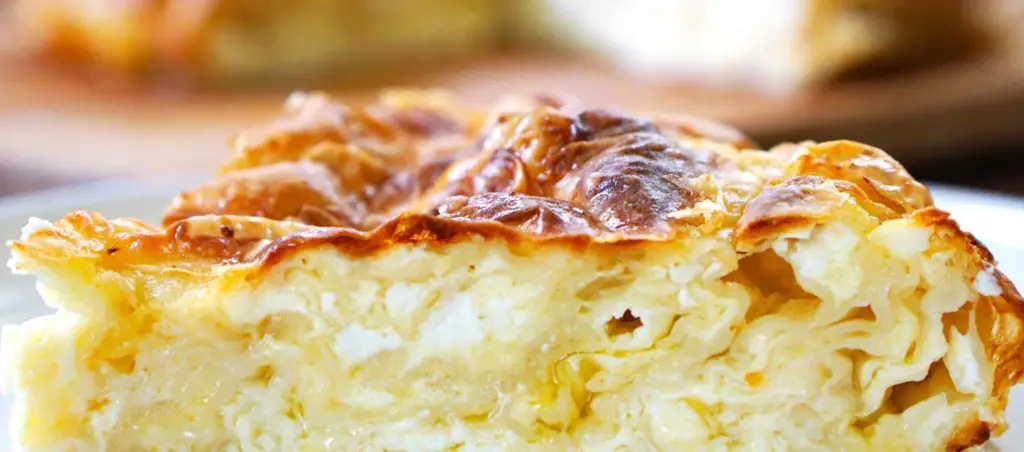
National Dish of Bulgaria – Banitsa Background
Originating from the Ottoman era, Banitsa is a delicious pastry dish often served during special occasions like Christmas and New Year’s.
Filled with cheese and eggs, this savory treat is perfect for breakfast or a quick snack.
Bulgarian Cuisine – Ingredients for Banitsa
- Phyllo dough sheets
- 200g of Bulgarian feta cheese
- 3 eggs
- 50ml of yogurt
- 100g of butter
How to prepare the National Dish of Bulgaria
Melt butter and brush it on each phyllo sheet. Mix feta cheese, yogurt, and eggs to make the filling. Layer the sheets, adding the filling between each. Roll and shape as desired. Bake at 180°C until golden brown.
Serve it warm, sliced into squares or triangles. A cool glass of Ayran, a yogurt-based drink, complements Banitsa beautifully.
Bulgarian Cuisine – Tarator
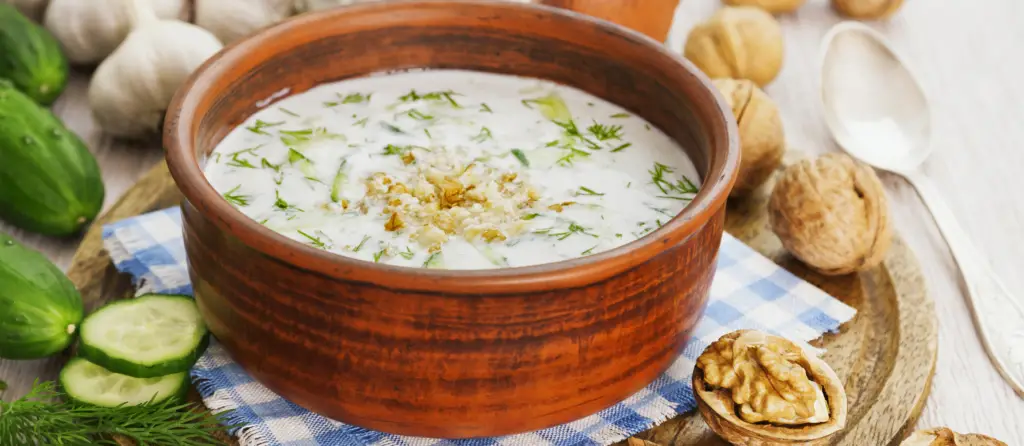
A refreshing summer soup, Tarator is made from yogurt, cucumbers, dill, and garlic. A staple during the hot months, it’s both cooling and nutritious.
Ingredients for Tarator
- 500ml yogurt
- 2 cucumbers, diced
- 2 cloves garlic, minced
- 2 tbsp dill, chopped.
- Salt and a splash of oil
How to prepare Tarator
Mix all ingredients in a bowl. Add water to achieve desired consistency. Chill before serving.
Present in bowls with a sprinkle of walnuts or dill on top. Tarator pairs wonderfully with white wine or a cold Bulgarian beer.
Bulgarian Cuisine – Kavarma

This slow-cooked meat stew has ancient roots and is commonly prepared during festive times or family gatherings.
Bulgarian Cuisine – Ingredients for Kavarma
- Pork or chicken pieces
- Onions, finely chopped
- Red bell peppers, sliced
- Tomatoes, diced
- Paprika
- White wine
- Vegetable oil or sunflower oil
- Salt and pepper to taste
Bulgarian Cuisine – How to prepare Kavarma
Brown the meat in oil, add onions and cook until translucent. Incorporate the peppers and tomatoes, followed by spices. Deglaze with white wine and simmer until the meat is tender.
Presentation and Serving
Serve hot in a clay pot or deep dish. Garnishing with fresh parsley enhances the visual appeal.
Drink Pairing
A full-bodied Bulgarian red wine complements the rich flavors of Kavarma.
Bulgarian Cuisine – Moussaka

Bulgarian Moussaka is different from its Greek counterpart. It is a beloved family dish, often prepared for Sunday meals.
Bulgarian Cuisine – Ingredients for Moussaka
- Potatoes, thinly sliced
- Ground pork or beef
- Onions, chopped
- Tomatoes, chopped
- Eggs
- Yogurt
- Salt, pepper, and savory to taste
Bulgarian Cuisine – How to prepare Moussaka
Fry the onions, add meat, and cook until browned. Add tomatoes and spices. Layer a dish with potatoes, then meat mixture. Repeat. Beat eggs with yogurt and pour over the dish. Bake until set.
Presentation and Serving
Serve hot, cutting into square portions.
Drink Pairing
A chilled beer or red wine complements the dish.
Bulgarian Cuisine – Kiselo Mlyako and Honey
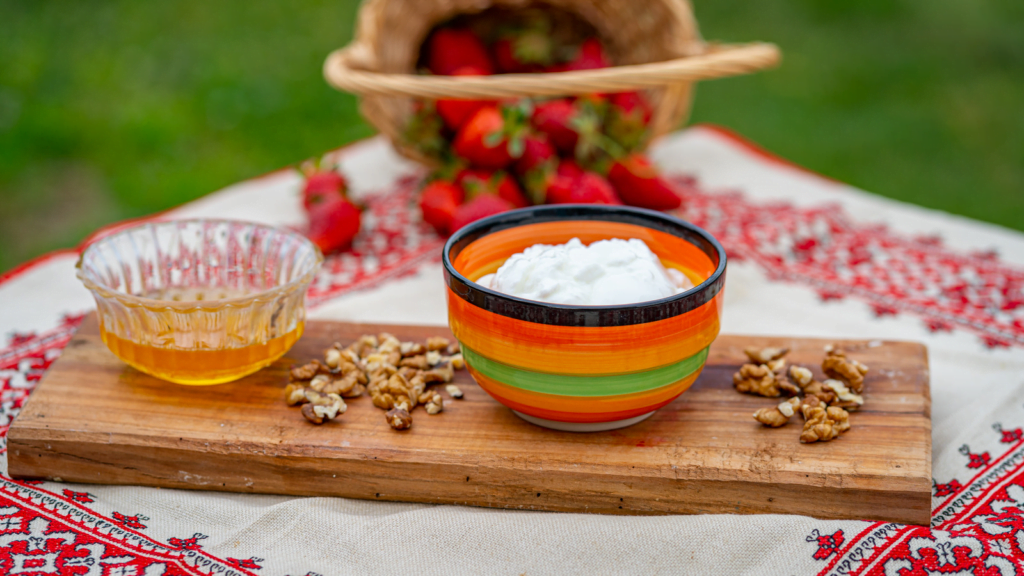
This simple yet delightful pudding is an ode to Bulgaria’s ancient dairy traditions. Originating from the Thracian times, kiselo mlyako (or yogurt) is a staple in Bulgarian homes. Combining it with honey brings out a natural sweetness and depth.
Ingredients for Kiselo Mlyako and Honey
- Homemade or store-bought Bulgarian yogurt (kiselo mlyako)
- Fresh, organic honey
How to prepare Kiselo Mlyako and Honey
In a bowl, pour a generous amount of kiselo mlyako. Drizzle the honey over the top, ensuring it’s evenly distributed. Gently stir to incorporate the honey, but not too much as you still want swirls of honey throughout.
Presentation
Serve in individual bowls or glass cups. Garnish with a mint leaf or a sprinkle of crushed walnuts for added texture and presentation.
Drink Pairing
A cup of herbal tea, preferably linden or chamomile, complements this dish beautifully, enhancing its natural sweetness.
Bulgarian Cuisine – Tikvenik

Tikvenik is a sweet pastry dish made from thin phyllo dough and pumpkin. Often associated with cold winter days and family gatherings, it’s a favorite during the holiday season.
Ingredients for Tikvenik
- 500g pumpkin, grated
- 1 cup sugar
- 1 tsp cinnamon
- 1 package phyllo dough sheets
- 200g melted butter
How to prepare Tikvenik
Start by mixing the grated pumpkin, sugar, and cinnamon in a bowl. Lay out one sheet of phyllo dough and brush it with melted butter. Spread a portion of the pumpkin mixture over the sheet. Roll it up and place it in a greased baking dish. Repeat with remaining sheets. Bake in a preheated oven at 180°C (350°F) for about 30 minutes or until golden brown.
Presentation
Cut the Tikvenik into squares while still warm. Dust with powdered sugar for a festive look.
Drink Pairing
A glass of warm Rakia, Bulgaria’s traditional fruit brandy, is the perfect partner for Tikvenik.
Conclusion
Bulgarian cuisine offers a rich tapestry of flavors, built upon centuries of tradition and influenced by its diverse geography and history. It reflects the country’s position at the crossroads of Europe and Asia, offering a unique blend of dishes that are both comforting and exotic. Whether you’re sampling a hearty Banitsa for breakfast or indulging in a bowl of kavarma for dinner, Bulgarian food promises an unforgettable gastronomic journey.
FAQ’s
What is the National Dish Of Bulgaria?
The national dish of Bulgaria is a traditional meal called “banitsa.” It is a savory pastry made with layers of filo dough and a filling of cheese, eggs, and yogurt. Banitsa is often enjoyed for breakfast or as a snack and is a popular choice during holidays and special occasions in Bulgaria.
What is the staple food in Bulgaria?
The staple foods in Bulgaria include bread, yogurt, cheese, fresh vegetables, and meats, especially pork. Bulgarians also consume a significant amount of beans and lentils.
What is Banitsa?
Banitsa is a traditional Bulgarian pastry made of thin phyllo dough layers filled with a mixture of eggs and cheese, typically feta. It can be served for breakfast or as a snack.
Are there vegetarian dishes in Bulgarian cuisine?
Yes, Bulgarian cuisine offers several vegetarian options, like tarator (a cold cucumber yogurt soup) and sarmi (cabbage or grape leaves stuffed with rice and spices).
How important is yogurt in Bulgarian food?
Yogurt is fundamental in Bulgarian cuisine. Not only is it consumed on its own, but it’s also an ingredient in various dishes. Bulgaria is famous for its unique strain of bacteria used in yogurt production, Lactobacillus bulgaricus.
What is Kavarma?
Kavarma is a popular Bulgarian dish made of meat (usually pork or chicken) stewed with spices, wine, and vegetables. It’s served in a clay pot and often accompanied by rice or bread.
Are Bulgarian Desserts Sweet?
Yes, Bulgarian desserts are typically sweet and often incorporate fruits, nuts, honey, and syrup. Popular choices include baklava, tulumbe, and garash cake.

